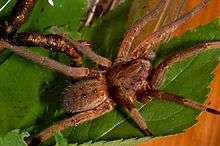Ancylometes
Ancylometes is a genus of Central and South American semiaquatic wandering spiders first described by Philipp Bertkau in 1880.[3] Originally placed with the nursery web spiders, it was moved to the Ctenidae in 1967.[4] The genus name is derived in part from Ancient Greek "ἀγκύλος" (ancylo-), meaning "crooked, bent".
| Ancylometes | |
|---|---|
 | |
| Ancylometes bogotensis | |
| Scientific classification | |
| Kingdom: | Animalia |
| Phylum: | Arthropoda |
| Subphylum: | Chelicerata |
| Class: | Arachnida |
| Order: | Araneae |
| Infraorder: | Araneomorphae |
| Family: | Ctenidae |
| Genus: | Ancylometes Bertkau, 1880[1] |
| Type species | |
| A. concolor (Perty, 1833) | |
| Species | |
|
11, see text | |
| Synonyms[1] | |
| |
These spiders live near ponds, lakes, rivers and other freshwater habitats, and can walk on water like water striders due to fine air-trapping hairs on the tips of their legs. They can also dive under the surface, and can stay underwater for over an hour by using the air trapped in hairs surrounding their book lungs. They will consume anything from insects to small lizards and, occasionally, small fish.[5][6]
Description
Members of Ancylometes are among the largest araneomorph spiders, with a typical body length of 1.5 to 4 cm (0.59 to 1.57 in). They are sometimes referred to as "giant fishing spiders" to distinguish them from Dolomedes, a genus of smaller spiders also called "fishing spiders". The largest species is A. rufus, with females that grow to a body length of 5 cm (2.0 in) and a leg span of 12 cm (4.7 in).[6] Males of the species only grow up to 3 cm (1.2 in) in body length, but usually have longer legs than the females. Both sexes are brown with dark spots on the abdomen, and males have two thin lines along their carapace.[7]
They have a 2-4-2 eye pattern and a reduced third claw, characteristics of the Ctenidae and Pisauridae, respectively. Members of this genus can be distinguished from all others by ventral spines found on the tarsi of the third and fourth legs.[6]
Ancylometes and the more fully aquatic Argyroneta are the only known genera of spiders that can spin webs in water. Though these webs can catch fish, they mostly prey on fish by diving down or lying in wait until prey passes within striking distance. Once caught, these spiders will bring their prey back to the surface before eating it.
During mating, the male wraps the female with silk, and the female enters an immobile state. After about a week, she produces a cocoon and carries it with her fangs. After a month, she builds a nursery web above the ground, about 10 centimetres (3.9 in) in diameter. Over one hundred baby spiders will hatch inside this egg case, each only about 2 millimetres (0.079 in) long. The baby spiders take about a year to mature. Males only live for sixteen months at most, while females can live for more than two years.
Species
As of April 2019 it contains eleven species:[1]
- Ancylometes amazonicus Simon, 1898 – Peru, Brazil
- Ancylometes birabeni (Carcavallo & Martínez, 1961) – Argentina
- Ancylometes bogotensis (Keyserling, 1877) – Honduras to Bolivia
- Ancylometes concolor (Perty, 1833) (type) – Brazil, Bolivia, Paraguay, Argentina
- Ancylometes hewitsoni (F. O. Pickard-Cambridge, 1897) – Bolivia, Brazil
- Ancylometes japura Höfer & Brescovit, 2000 – Brazil
- Ancylometes jau Höfer & Brescovit, 2000 – Brazil
- Ancylometes pantanal Höfer & Brescovit, 2000 – Brazil
- Ancylometes riparius Höfer & Brescovit, 2000 – Brazil
- Ancylometes rufus (Walckenaer, 1837) – Northern South America
- Ancylometes terrenus Höfer & Brescovit, 2000 – Brazil
References
- "Gen. Ancylometes Bertkau, 1880". World Spider Catalog Version 20.0. Natural History Museum Bern. 2019. doi:10.24436/2. Retrieved 2019-05-23.
- Schiapelli, R. D.; Gerschman de P., B. S. (1970). "Consideraciones sobre el género Ancylometes Bertkau 1880 (Araneae: Pisauridae)". Acta Zoologica Lilloana. 27: 165.
- Bertkau, P. (1880). "Verzeichniss der von Prof. Ed. van Beneden auf seiner im Auftrage der Belgischen Regierung unternommen wissenschaftlichen Reise nach Brasilien und La Plata im Jahren 1872-73 gensammelten Arachniden". Mémoires Couronnés et Mémoires des Savants Étrangers de l'Académie Royale des Sciences, des Lettres et des Beaux-Arts de Belgique. 43: 1–120.
- Lehtinen, P. T. (1967). "Classification of the cribellate spiders and some allied families, with notes on the evolution of the suborder Araneomorpha". Annales Zoologici Fennici. 4: 214.
- "Ancyclometes". intute. Archived from the original on 2008-04-29. Retrieved 2019-05-23.
- "Ancylometes – introduction". State Museum of Natural History Karlsruhe. Retrieved 2019-05-23.
- Höfer, H.; Brescovit, Antônio D. (2000). "A revision of the Neotropical spider genus Ancylometes Bertkau (Araneae: Pisauridae)". Insect Systematics & Evolution. 31 (3): 323–360. doi:10.1163/187631200x00075.
Further reading
- Gasnier, T.R., Salette de Azevedo, C., Torres-Sanchez, M.P. & Höfer, H. (2002). Adult size of eight hunting spider species in Central Amazonia: Temporal variations and sexual dimorphisms. Journal of Arachnology 30:146-154. PDF
- Walking on the water: Biology and captive breeding of giant fishing spider Ancylometes
- Merrett, P. (1988). Notes on the biology of the neotropical pisaurid, Ancylometes bogotensis (Keyserling) (Araneae: Pisauridae). Bull. Br. arachnol. Soc. 7:197-201.
External links
| Wikimedia Commons has media related to Ancylometes. |